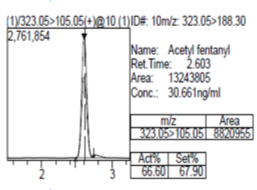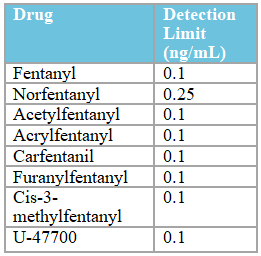Fentanyl Analogues and the Opioid Epidemic
Dr. Joseph E. Graas, Scientific Director
Dr. Edward Moore, Medical Director
Dr. Paul Robandt, Scientific Director
Last winter, the Toxicology Times published a two-part series on fentanyl in relationship to the opioid crisis in the United States. San Diego Reference Laboratory is now offering an expanded confirmation panel to analyze fentanyl, norfentanyl and six analogs of fentanyl in urine specimens to aid you in the detection of opioid abuse.
While SDRL was developing the expanded fentanyls analysis, we were already detecting acetylfentanyl in patient samples. Here is an actual chromatogram of 30 ng/mL acetylfentanyl along with the detection limits of our assay:


Fentanyl analogues (fentanyls) are increasingly involved in overdose deaths, up as much as 540% in the last three years.1 In 2017, nearly 200 people died from drug overdoses every day. Carfentanil is so toxic that the DEA has issued a safety bulletin to police and safety responders with recommendations as to how to recognize and safely handle drug substances that may contain carfentanil.2
Fentanyl (also known as fentanil) was developed as a pain medication that is 50 to 100 times more potent than morphine.3 Because fentanyl has a rapid onset of action, a relatively short duration, and less of an effect on blood pressure, it became the anesthetic of choice in cardiac surgery. 1,700 kilograms of fentanyl were used globally in 2013.4
Analogues of fentanyl have been made for pharmaceutical markets, most notably alfentanil and sufentanil, for use in pain relief and heart surgery, respectively. Other synthetic analogues have been copied from research articles by clandestine labs. For example, ohmefentanyl is 6,300 times stronger than morphine and carfentanil is 10,000 times stronger than morphine. Both are available by mail order as “research chemicals” from China.
Classified as a Schedule II drug by the DEA decades ago, fentanyl was unregulated in China until only very recently. Clandestine Chinese labs sell fentanyl and analogues of fentanyl to smugglers and cartels and have even branched out into the mail order business. Drug cartels learned that the manufacturing and transportation of fentanyl was easier and delivered a higher profit margin than trafficking in conventional drugs. This, coupled with the downturn of the US illicit marijuana trade caused the cartels to promote fentanyl distribution into the United States.
![]()
References
- The First Count of Fentanyl Deaths in 2016: Up 540% in Three Years, The New York Times, J. Katz, 2017
- Carfentanil: A Dangerous New Factor in the U.S. Opioid Crisis – US Drug Enforcement Administration, https://www.hsdl.org/?view&did=795829 (2016)
- Drug Facts: Fentanyl. National Institute on Drug Abuse, US National Institutes of Health. June 2016. Retrieved 19 March 2017.
- Narcotic Drugs 2014. International Narcotics Control Board. 2015. p. 21. ISBN 9789210481571.
